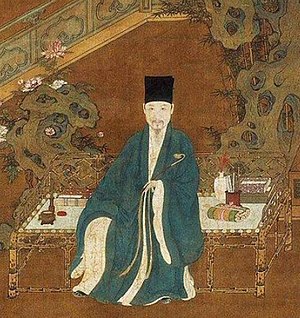
Back مى فو ARZ Мі Фэй Byelorussian མི་ཧྥུ། Tibetan Mi Fu Catalan می فو CKB Mi Fu Czech Mi Fu German Mi Fu Esperanto Mi-Fei Spanish Mi Fu Basque
This article has multiple issues. Please help improve it or discuss these issues on the talk page. (Learn how and when to remove these template messages)
|
| Mi Fu | |||||||||||||||||
|---|---|---|---|---|---|---|---|---|---|---|---|---|---|---|---|---|---|
 Mi Fu as depicted in a 1107 CE painting by Chao Buzhi | |||||||||||||||||
| Chinese name | |||||||||||||||||
| Chinese | 米芾 or 米黻 | ||||||||||||||||
| |||||||||||||||||
| Korean name | |||||||||||||||||
| Hangul | 미불 | ||||||||||||||||
| |||||||||||||||||
| Japanese name | |||||||||||||||||
| Hiragana | べいふつ | ||||||||||||||||
| |||||||||||||||||
Mi Fu (Chinese: 米芾 or 米黻; pinyin: Mǐ Fú, also given as Mi Fei, 1051–1107 CE)[1] was a Chinese painter, poet and calligrapher who was born in Taiyuan during the Song dynasty. He became known for his style of painting misty landscapes. This style would be deemed the "Mi Fu" style and involved the use of large wet dots of ink applied with a flat brush. His poetry was influenced by Li Bai and his calligraphy by Wang Xizhi.
Mi Fu is regarded as one of the four greatest calligraphers of the Song dynasty, alongside Su Shi, Hung Tingjian and Cai Xian. His style is derived from calligraphers in earlier dynasties, although he developed unique traits of his own. His son, Mi Youren, also became a well known painter. He followed his father's artistic style, adopting his use of large dots of wet ink, a technique later nicknamed "Mi Dots".[2]
As a personality, Mi Fu was noted as an eccentric; including a mania of cleanliness.[2] At times, he was deemed "Madman Mi" due to his obsession with collecting stones. He was also known to be a heavy drinker. His son, Mi Youren, also became a well known painter following in his father's artistic style.
- ^ Barnhart: 373. His courtesy name was Yuanzhang (元章) with several sobriquets: Nangong (南宮), Lumen Jushi (鹿門居士), Xiangyang Manshi (襄陽漫士), and Haiyue Waishi (海岳外史)
- ^ a b Sturman, Peter Charles (1 January 1997). Mi Fu: Style and the Art of Calligraphy in Northern Song China. Yale University Press. p. 214. ISBN 978-0-300-06569-5. Retrieved 5 September 2022.
© MMXXIII Rich X Search. We shall prevail. All rights reserved. Rich X Search